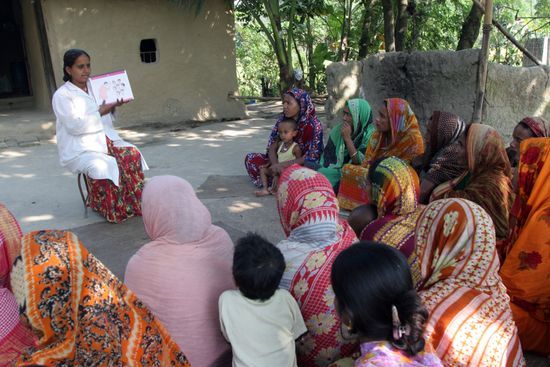
Tuberculosis (TB) remains one of the most important transmissible conditions of public health concern in both low- and high-resource settings, and is one of the single most important infectious disease killers. As part of its mandate, the World Health Organization produces evidence-based guidelines on different aspects of TB prevention, screening, diagnosis and treatment. Since several years, TB guidelines are developed using using the GRADE method (Grading of Recommendations Assessment, Development and Evaluation).
All healthcare personnel involved in TB prevention and care need to have appropriate knowledge and skills on how to use WHO TB guidance. The training course on Understanding and using WHO guidelines on tuberculosis were developed for persons with different levels of experience in using WHO TB guidelines. This e-Learning package consists of 8 modules, which include video lectures and downloadable presentations that reflect the latest information and methods.
Photo credits: WHO/G.Hampton
Language: English
Basic (Basique), Tuberculosis
Course information
Overview: Since 2009, WHO has produced tuberculosis (TB) guidelines using the GRADE method (Grading of Recommendations Assessment, Development and Evaluation). More recently, the WHO Global TB Programme has consolidated its TB guidelines into a modular series, including access to a recommendation map, focused on online access in contrast to paper documents. Evidence-based guidance across the continuum of care is instrumental to the global drive to end TB, a leading infectious disease cause of death in the world today despite being largely preventable and curable. This is enshrined in the WHO End TB Strategy for 2016-2035 endorsed by all Member States. Efforts to keep consolidated guidelines updated as “living guidelines” are important for WHO so that practice is based on the best available, latest evidence.
This course explains how TB guidelines are developed by WHO, how the GRADE approach relates to TB guidelines, how to interpret the certainty of evidence and strength of recommendations, how WHO TB guidelines can be accessed, and how guidelines can be adapted to the local context.
The target audience for these training modules include personnel involved in the public health response to TB, including clinicians and other healthcare professionals, public health officials, programme managers, academics as well as other interested learners including the public.
Course duration: This course should take approximately 4 hours to complete.
Certificates: A Record of Achievement will be available to participants who score at least 80% of the total points available in the final assessment. A Confirmation of Participation certificate is also available for participants who complete at least 80% of the course material. Participants who receive a Record of Achievement can also download an Open Badge for this course. Click here to learn how.
What you'll learn
- Describe the general process of WHO TB guideline development
- Describe what a WHO TB guideline includes
- Access WHO TB recommendations
- Describe the certainty of the evidence and what it means
- Explain strong and conditional recommendations
- Explain the rationale for adapting guideline recommendations
Who this course is for
- Guideline users and teams supporting guideline development
Course contents
Module 1: How are WHO tuberculosis guideline recommendations developed?:
After completion of this module, learners will be able to describe the general process of WHO tuberculosis guideline development and what a guideline includes, from questions to recommendationsModule 2: Accessing WHO tuberculosis recommendations. An overview of the resources and tools:
After completion of this module, learners will be able to describe how and where to access WHO tuberculosis recommendations and what tools can be used to implement themModule 3: An overview of GRADE in the context of WHO tuberculosis recommendations:
This module has two sections: 3a is for guideline developers, and 3b for guideline users. After completion of module 3a), learners who are tuberculosis guideline developers will describe what GRADE is and its significance for TB guidelines. After completion of module 3b), learners who are lay user of a recommendation will describe what GRADE is and its significance for TB guidelines.Module 4: Understanding WHO tuberculosis recommendations focusing on tests:
After completion of this module, learners will be able to describe the key considerations about using recommendations about tests for tuberculosis and how they differ from recommendations about drugs and other treatments in their development and interpretationModule 5: Understanding strong and conditional recommendations in WHO tuberculosis guidelines:
After completion of this module, learners will be able to explain the difference between strong and conditional WHO tuberculosis recommendations and interpret themModule 6: Understanding high, moderate, low and very low certainty evidence in WHO tuberculosis guidelines:
After completion of this module, learners will be able to explain the meaning of the certainty of evidence of WHO tuberculosis recommendations and interpret itModule 7: Using GRADE Adolopment to adapt or adopt WHO tuberculosis guidelines:
After completion of this module, learners will be able to explain why guideline adaptation provides advantages and how recommendations can be adapted, adopted or created from an existing WHO tuberculosis guidelineModule 8: Using WHO tuberculosis recommendations – do I need to contextualize the recommendations?:
After completion of this module, learners will be able to describe the key factors to consider in and the rationale for contextualizing WHO tuberculosis guideline recommendations. This will complete the training course and they can go to the Final Assessment.Final Assessment
Enroll me for this course
Certificate Requirements
- Gain a Record of Achievement by earning at least 80% of the maximum number of points from all graded assignments.
- Gain a Confirmation of Participation by completing at least 80% of the course material.